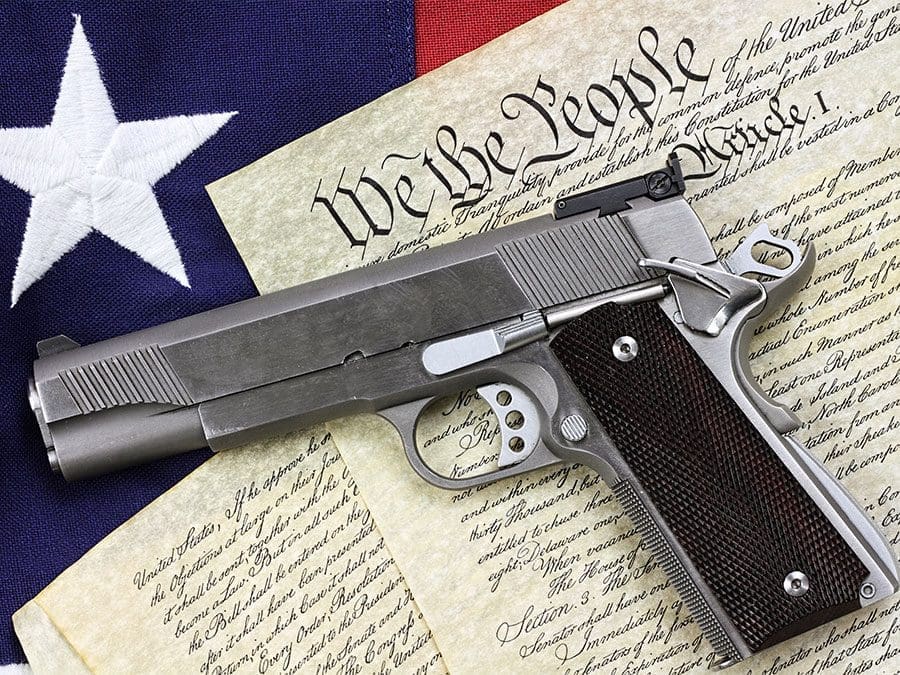When the legislative session began in early January, gun rights were expected to take center stage. “Constitutional carry,” “open carry,” “campus carry,” and other measures dominated much of the conversation and drew some of the strongest testimony in public hearings.
|
During the interim, Second Amendment advocates were successful in having constitutional carry – the right to carry a handgun openly or concealed without a government issued license – listed as the top legislative priority of the Texas GOP. Following intense activism from several open carry groups and related media coverage, it was clear that the legislature was likely to show some movement on the issue after years of stagnation. The incoming governor and lieutenant governor, Greg Abbott and Dan Patrick, both endorsed open carry and campus carry laws, though without providing specifics.
As lawmakers arrived in Austin, two conservatives stood out from the pack. State Rep. Jonathan Stickland (R-Bedford), a lawmaker known for never being afraid to grab a bull by the horns, found a partner in State Sen. Don Huffines (R-Dallas). Huffines was fresh off a Republican primary victory in which he dispatched liberal incumbent John Carona. Together, Stickland and Huffines filed legislation that quickly became known as “constitutional carry.”
Their legislation would repeal regulations requiring Texans to have a license to carry a handgun concealed or openly. Though the Texas State Rifle Association (TSRA) passed on the bill – favoring licensed open carry instead – other Second Amendment organizations including Open Carry Texas, Open Carry Tarrant County, and Texas Gun Rights offered their support.
Passions ran high.
In one interaction, activists with Open Carry Tarrant County confronted State Rep. Poncho Nevarez (D-Eagle Pass), prompting security to be called. The confrontation was exploited by anti-gun Democrats to create political drama and paint open carry as an extreme proposal, despite being legal in more than 40 states. Nevarez and fellow Democrat Rep. Trey Martinez Fischer (D-San Antonio) pushed a rule change to allow legislators to install “panic buttons” in their offices in case of another intense argument with Second Amendment activists.
The effort was political theater to create a climate of fear in Austin over the impending issue of open carry. Though the rule change passed, a review by conservative blogger Adam Cahn later revealed that Nevarez – the marquee “victim” of the open carry activists – never even requested one of the buttons. Nevertheless, Nevarez earned the nickname “Panic Button Poncho.”
While the aggressive tactics of some of the open carry groups – which favored constitutional carry – might have soured legislators on their specific proposal, the attention raised the profile of Second Amendment issues overall. In the House, Public Safety Committee Chairman Larry Phillips (R-Sherman) picked up the issue, filing House Bill 910.
However, instead of repealing licensing requirements to carry a handgun, Phillips’ legislation mirrored a Senate proposal by State Sen. Craig Estes (R-Wichita Falls) and centered on reforming existing concealed handgun license (CHL) regulations to allow licensees to carry their handguns in an open manner.
However, Senate opposition led Patrick, a vocal supporter of open carry, to question the viability of constitutional carry. In an interview with the Texas Tribune, Patrick noted that he did not believe that he had the votes to pass the measure, prompting an immediate outcry from Second Amendment activists.
“When Patrick said that to the Tribune I just thought ‘Oh my gosh’ and hunkered down,” said Alice Tripp, Legislative Director for the Texas State Rifle Association. “I put on my Kevlar helmet, got in my foxhole, and watched the bombs go off.”
Indeed, the bombs did go off as Texas Gun Rights and other groups lit up the Capitol switchboard for a solid week, with Texans urging Patrick and other lawmakers to support the GOP priority. The public pressure worked.
“By the time the dust settled,” said Tripp. “Estes’ SB 346 had become SB 17, a lieutenant governor priority bill.”
On campus carry – the right of handgun licensees to defend themselves on college campuses – the battle lines were substantially clearer. State Rep. Allen Fletcher (R-Cypress) filed a campus carry bill in the House. Fletcher had pushed the bill unsuccessfully in three previous sessions, despite Republican majorities.
Riding alongside Fletcher was State Sen. Birdwell (R-Waco), who also had a long history of support for campus carry and authored the Senate’s companion legislation. The upper chamber seemed poised to pass the measure after Patrick gave it his blessing, and more importantly, after Senate Republicans delivered on Patrick’s pledge to repeal the toxic 2/3 Rule. In past sessions, it had provided convenient cover to liberal Senate Republicans seeking to hide behind Democrat opposition to 2nd Amendment rights and other Republican priorities.
In the House, the climate was much of the opposite. Newly minted University of Texas Chancellor William McRaven had come out strongly against the measure. In an interview with UT’s Jim Henson, House Speaker Joe Straus (R-San Antonio) cited McRaven in expressing his own opposition to allowing law-abiding citizens to defend themselves on college campuses.
By the beginning of February, the chances for advancing Second Amendment rights were arrayed like chess pieces on a hostile board. It would take a careful, consistent effort to ensure the reforms did not fall subject to the same pitfalls that had plagued them in previous sessions, or fall victim to procedural traps devised by liberal Republicans and their Democrat allies.





